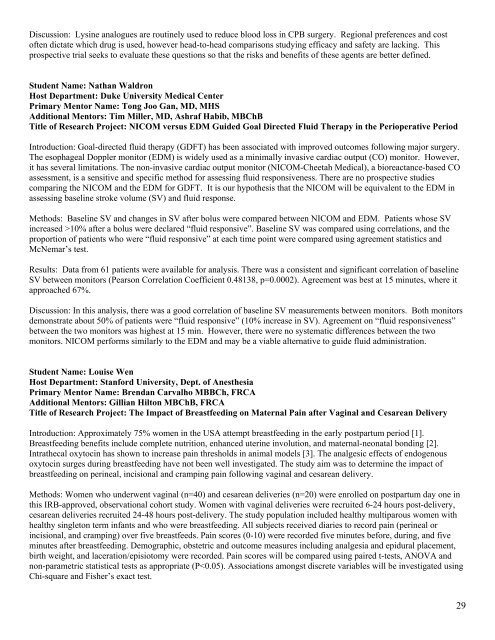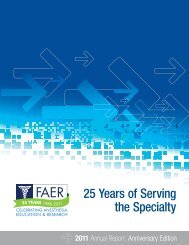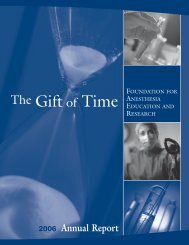2010 MSARF Symposium Participants - Foundation for Anesthesia ...
2010 MSARF Symposium Participants - Foundation for Anesthesia ...
2010 MSARF Symposium Participants - Foundation for Anesthesia ...
You also want an ePaper? Increase the reach of your titles
YUMPU automatically turns print PDFs into web optimized ePapers that Google loves.
Discussion: Lysine analogues are routinely used to reduce blood loss in CPB surgery. Regional preferences and cost<br />
often dictate which drug is used, however head-to-head comparisons studying efficacy and safety are lacking. This<br />
prospective trial seeks to evaluate these questions so that the risks and benefits of these agents are better defined.<br />
Student Name: Nathan Waldron<br />
Host Department: Duke University Medical Center<br />
Primary Mentor Name: Tong Joo Gan, MD, MHS<br />
Additional Mentors: Tim Miller, MD, Ashraf Habib, MBChB<br />
Title of Research Project: NICOM versus EDM Guided Goal Directed Fluid Therapy in the Perioperative Period<br />
Introduction: Goal-directed fluid therapy (GDFT) has been associated with improved outcomes following major surgery.<br />
The esophageal Doppler monitor (EDM) is widely used as a minimally invasive cardiac output (CO) monitor. However,<br />
it has several limitations. The non-invasive cardiac output monitor (NICOM-Cheetah Medical), a bioreactance-based CO<br />
assessment, is a sensitive and specific method <strong>for</strong> assessing fluid responsiveness. There are no prospective studies<br />
comparing the NICOM and the EDM <strong>for</strong> GDFT. It is our hypothesis that the NICOM will be equivalent to the EDM in<br />
assessing baseline stroke volume (SV) and fluid response.<br />
Methods: Baseline SV and changes in SV after bolus were compared between NICOM and EDM. Patients whose SV<br />
increased >10% after a bolus were declared “fluid responsive”. Baseline SV was compared using correlations, and the<br />
proportion of patients who were “fluid responsive” at each time point were compared using agreement statistics and<br />
McNemar’s test.<br />
Results: Data from 61 patients were available <strong>for</strong> analysis. There was a consistent and significant correlation of baseline<br />
SV between monitors (Pearson Correlation Coefficient 0.48138, p=0.0002). Agreement was best at 15 minutes, where it<br />
approached 67%.<br />
Discussion: In this analysis, there was a good correlation of baseline SV measurements between monitors. Both monitors<br />
demonstrate about 50% of patients were “fluid responsive” (10% increase in SV). Agreement on “fluid responsiveness”<br />
between the two monitors was highest at 15 min. However, there were no systematic differences between the two<br />
monitors. NICOM per<strong>for</strong>ms similarly to the EDM and may be a viable alternative to guide fluid administration.<br />
Student Name: Louise Wen<br />
Host Department: Stan<strong>for</strong>d University, Dept. of <strong>Anesthesia</strong><br />
Primary Mentor Name: Brendan Carvalho MBBCh, FRCA<br />
Additional Mentors: Gillian Hilton MBChB, FRCA<br />
Title of Research Project: The Impact of Breastfeeding on Maternal Pain after Vaginal and Cesarean Delivery<br />
Introduction: Approximately 75% women in the USA attempt breastfeeding in the early postpartum period [1].<br />
Breastfeeding benefits include complete nutrition, enhanced uterine involution, and maternal-neonatal bonding [2].<br />
Intrathecal oxytocin has shown to increase pain thresholds in animal models [3]. The analgesic effects of endogenous<br />
oxytocin surges during breastfeeding have not been well investigated. The study aim was to determine the impact of<br />
breastfeeding on perineal, incisional and cramping pain following vaginal and cesarean delivery.<br />
Methods: Women who underwent vaginal (n=40) and cesarean deliveries (n=20) were enrolled on postpartum day one in<br />
this IRB-approved, observational cohort study. Women with vaginal deliveries were recruited 6-24 hours post-delivery,<br />
cesarean deliveries recruited 24-48 hours post-delivery. The study population included healthy multiparous women with<br />
healthy singleton term infants and who were breastfeeding. All subjects received diaries to record pain (perineal or<br />
incisional, and cramping) over five breastfeeds. Pain scores (0-10) were recorded five minutes be<strong>for</strong>e, during, and five<br />
minutes after breastfeeding. Demographic, obstetric and outcome measures including analgesia and epidural placement,<br />
birth weight, and laceration/episiotomy were recorded. Pain scores will be compared using paired t-tests, ANOVA and<br />
non-parametric statistical tests as appropriate (P





